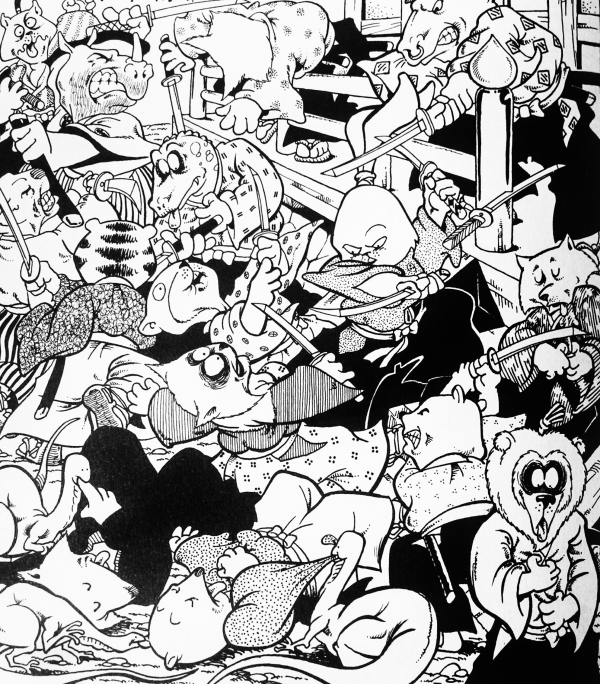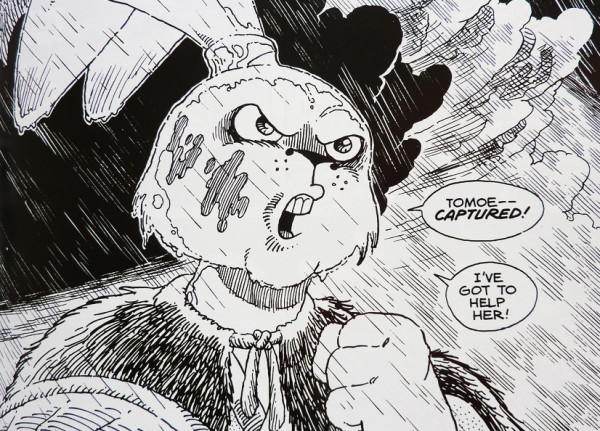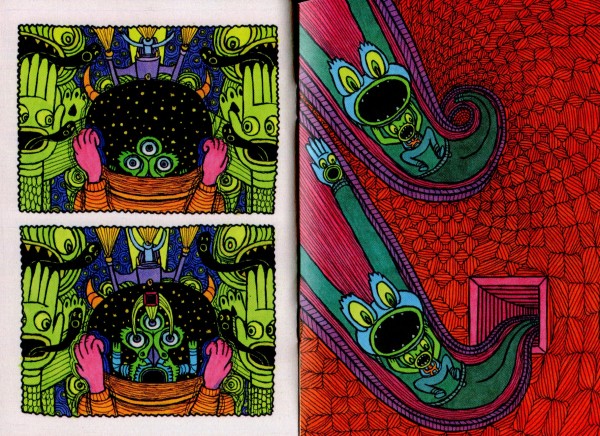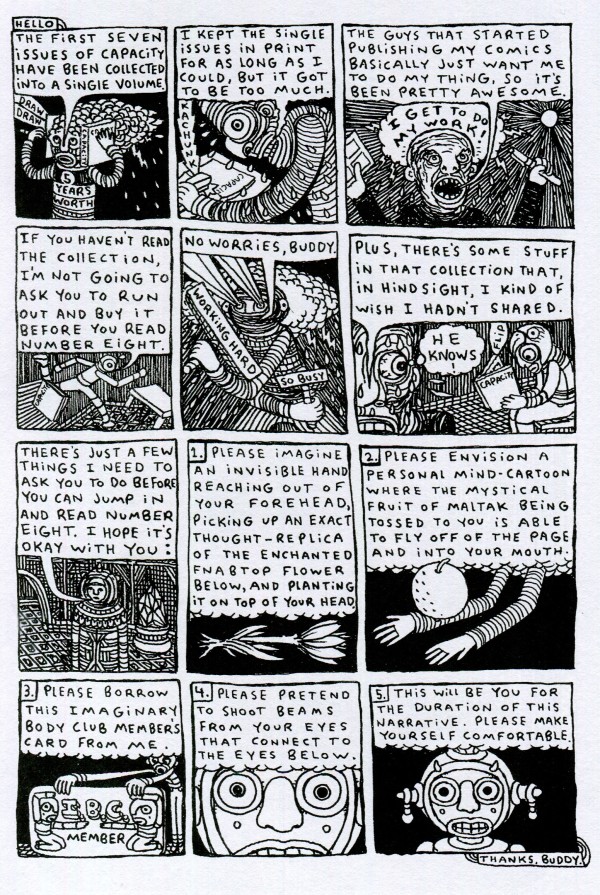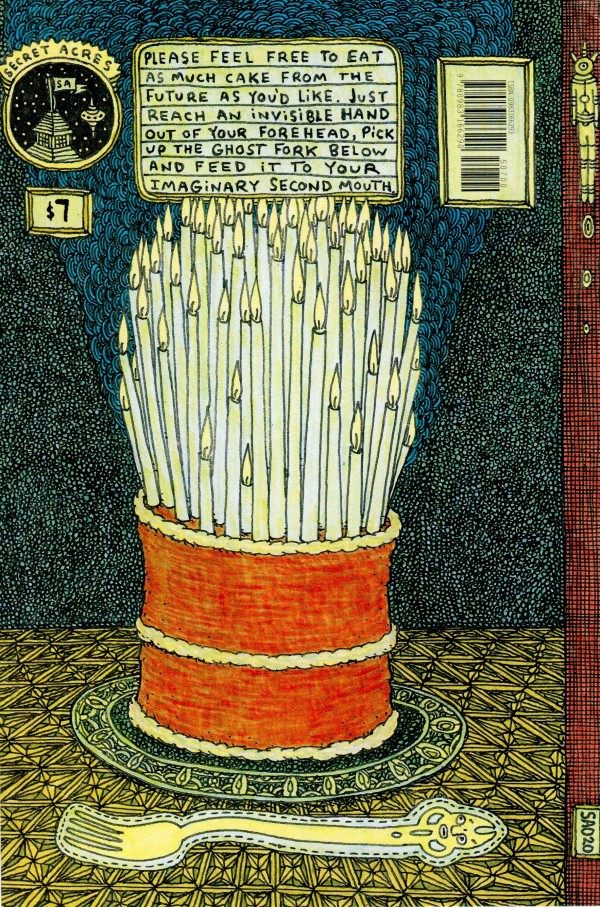What We’re Reading: Buffalo Bill in the Gallery of the Machines; Mystery Mark
My to-read shelf is full of spooky stories I failed to read in October and downer Scandinavian novels—it’s stuff that I don’t dare read in the gray unkindness of winter. Luckily, stuck between a glowering omnibus of a Sigrid Undset tetralogy and 1,000 pages of Hawthorne, I found a holdout of pulpy genre books.
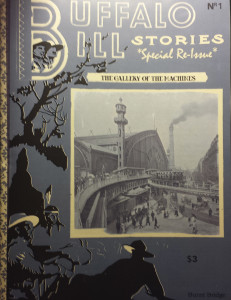 Buffalo Bill in the Gallery of the Machines by Mark Rapacz (self-published)
Buffalo Bill in the Gallery of the Machines by Mark Rapacz (self-published)
The magazine-sized Buffalo Bill is part of Rapacz’s impressive Pulp Curios package, a collection of handsomely printed novellas and magazines. In the Gallery of the Machines is a loyal homage to the Street & Smith dime novels, detailing the waning days of Buffalo Bill’s show and his commitment to the world around him.
Part of Bill’s show is the Patagonian giant, Boneshriek, and most of the short story’s conflict comes from his desire to leave the show due to recurring existential ennui—he isn’t sure where he comes from or where he belongs. Bill is adamant that Boneshriek’s place is in the show, breaking railroad ties and flipping carriages. Bill’s retention of Boneshriek becomes paradoxical, though; while the giant will benefit the Wild West Show, it also benefits Bill’s foil, Thomas Edison, who plans to use Boneshriek to exhibit his new direct current electricity. By keeping Boneshriek, Bill also contributes to the advent of electronic entertainment, displacing the human-powered show that keeps Bill and his show afloat.
Tragedy ensues, but it’s more immediate than anything Bill could have assumed. Bill’s drunken plodding toward the horrific ending makes In the Gallery of the Machines feel like a Greek tragedy; whether Boneshriek stayed or left, it would have been at Bill’s behest, and either way, Bill loses.
Rapacz keeps a careful handle on the dialogue, never slipping into the over-apostrophied renditions of bad Western slang. Buffalo Bill himself code-switches between the overblown speech patterns of the dime novels and the cosmopolitan accent of a tired soldier and world traveler. The narration flirts with the original pulps’ purple proses, but it shows enough restraint for modern readers.
He had seen a cold calf born in the dead of winter upon a field of snow. Saw it come sliding, half-froze, out of the mother. Watched it fall like a log into the bank. No steam rising from it. Its fluids thick and cold and jellied upon it.
If the Buffalo Bill’s electric tragedy isn’t enough, there’s bonus story at the end: “Crookstone,” is a creepy coda to the book. In the vein of Ambrose Bierce or Nathaniel Hawthorne, “Crookstone” is about an abandoned baby who won’t die, a backwoods kaiju, and the unknowable nature of the wild.
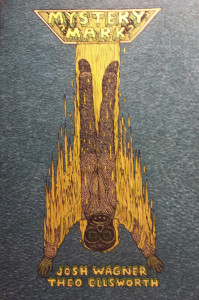 Mystery Mark by Josh Wagner & Theo Ellsworth (self-published)
Mystery Mark by Josh Wagner & Theo Ellsworth (self-published)
Where In the Gallery of the Machines is a modern iteration of a pulp, Mystery Mark is a shadowy echo of New Wave sci-fi. It feels like a Philip K. Dick adaptation of a Bruegel painting that’s been edited down to a blacklisted television pilot.
The book is a back-and-forth game of telephone between Wagner and Ellsworth—Wagner wrote words based on Ellsworth drawings who drew more based on the words and so on. It’s a quick read and is roughly the story of a scared man rediscovering hope, but it all takes place in a world of skeleton spies, spider safecrackers, face replacement surgeries, and a possibly sentient stuffed animal.
Wagner’s prose is straightforward—we’re told exactly what happens and how characters feel. In a naturalistic novel, this would most likely be a detriment, as we expect subtlety and metaphors in literary dramas. In Mystery Mark, though, the world itself is subtle (and sometimes not-so-subtle) metaphor, so the clear prose acts as a sugar coating that helps the oddness go down. Put another way, Ellsworth’s drawings lend the world a strange texture to which Wagner’s writing can play the straight man.
They were the best there ever was—at least that’s what they told each other, and got no argument from anyone. But jobs were scarce these days and competition was fierce. A skeleton had to stay on top of his game.
My one complaint regarding both Mystery Mark and In the Gallery of the Machines is the lack of lady agency. Each book contains a single woman. In Mystery Mark, it’s a snuggly nurse with nary a line of dialogue. Buffalo Bill gives us the legendary Annie Oakley, but we’re repeatedly told how she’s changed since she’s had kids. In the end, Bill narratively emasculates her, taking her gun to use in the fateful denouement. It felt like an aborted case of Chekhov’s gun; we’re shown this sharpshooter but never allowed to see her shoot. While it’s great to see older genres tweaked and reinvigorated, it’s too bad those genres’ gender politics weren’t updated too.
What We’re Reading: Usagi Yojimbo Special Edition
 Usagi Yojimbo: The Special Edition by Stan Sakai (Fantagraphics, 2015)
Usagi Yojimbo: The Special Edition by Stan Sakai (Fantagraphics, 2015)
In Stan Sakai’s Usagi Yojimbo, the titular character, Usagi Miyamoto, is a masterless samurai who wanders through Edo-period Japan. Broadly, the Special Edition collects the first nine years of Usagi: his first appearances in various furry animal anthologies and all 38 issues published by Fantagraphics. Additionally, there’s a how-to by the author, rare Teenage Mutant Ninja Turtles cameos, and an in-depth interview. The two books come in a handsome slipcase with striking colors, and the pages, despite being very thin, immaculately hold Sakai’s linework. Physically speaking, my only complaint is that the covers tend to warp; maybe some nice French flaps would have fixed that.
As for the stories themselves, well, Usagi spends a lot of time walking. While walking, he consistently revisits places both physically (his home village or the palace of Lord Noriyuki) and in memory (Adachi Plain, the site of the battle where Usagi’s lord died). Tropes are also constantly revisited and revised: Usagi sleeps in a haunted shack owned by a haunted woman; two woodcutting peasants cross Usagi’s path; or Usagi squabbles with bounty hunter Gen and blind masseur Zato Ino. The comic is iterative, constantly running its characters through the same equations.
Is this sort of repetition bad? In our world of remakes and sequels, there’s a certain stench, a certain wariness about retreading old ground. In American adventure comics, though, it’s almost a tradition. This is partly because these comics were one of the last refuges for untrained artists—they were arenas where people with moderate skills could get paid while they learned their craft. Some of the most historically important adventure comics—the origins of Superman and Batman, the first appearances of the Guardians of the Galaxy, the early issues of Teenage Mutant Ninja Turtles are naive and primitive stories. Because of this, they’re constantly revised as comics’ cultural cachet rises and cartoonists with more polish work on established properties.
This holds for the earliest Usagi stories, especially the ones from the Albedo and Critters anthologies. The characters are strangely proportioned and inconsistently portrayed. The hatching is ill-considered and ends up flattening the image instead of adding texture. The narration is blunt and boring. For example, here’s a mess of patterns and anatomy that’s very hard to read:
It’s joyous to watch how fast Sakai gets better. His pattern-making becomes a consistent backdrop, a foundation, for the pacing of the series. The wavy tree bark, the gentle fields, and the sound, believable buildings join into a rhythm of world-building that works as an attractive tableau without distracting from the characters. Here’s a much clearer panel, where each pen stroke carries much more weight:
Just as Sakai grows and changes by iterating on his settings and characters, Usagi returns to the same places again and again. However, instead of retreading the same dramas, each visit changes Usagi and is shaded by said changes. Despite superficially seeming to repeat itself, each repetition is a chance to show the small ways Usagi has changed. For example, Usagi is warned early on that he’s too inflexible and too willing to fight. On his first return to his home village, the tension with his childhood rival, Kennichi, is thick and overt. On future visits, though, after Usagi has seen the consequences of violence and hot-headedness, he becomes more patient with Kennichi and more accepting of Kennichi’s marriage to Mariko, Usagi’s first sweetheart.
Usagi Yojimbo, through its wanderings, shows what it takes to really know a person or place. A single experience, no matter how powerful, is only a single view. It takes spiraling around a place, seeing it in every season, and knowing it will change as you change.
What We’re Reading: Theo Ellsworth

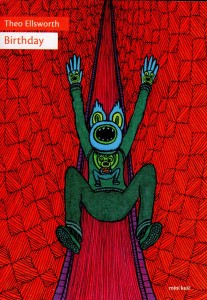 Birthday (mini kuš! #35) and Capacity #8 by Theo Ellsworth (Secret Acres, kuš! komiksi, 2015)
Birthday (mini kuš! #35) and Capacity #8 by Theo Ellsworth (Secret Acres, kuš! komiksi, 2015)
The only text relevant to Theo Ellsworth’s Birthday is on the back cover: “Our hero is insanely nervous. He’s about to undergo an intense psychic initiation known as the Inner-Space Birth Ritual. You’d be nervous, too!” From there, we’re on our own.
Luckily, Ellsworth’s art is filled with patterns of parallel lines and nested ornamentation, making each page feel like a woodcut. The level of detail combined with a complete lack of text encourage one to linger on every panel. The characters feel organically modular: the protagonist’s cloud of anxiety is dispelled to a fish mouth and replaced by a small spaceship-cum-hat. Later, inside a Birth Ritual Helmet, faces flash and change across its starry surface.
In the end, the protagonist is reduced (symbolically?) to a baby, cradled by a massive, smiling creature-structure. The Birth Ritual seems successful, and perhaps the baby has personified and utilized his negative aspects in the process; “process” is the key word here, since the book is more a process than a story. The minimalism is implicitly inviting.
On the other hand, Capacity is explicitly inviting. If Birthday is an organic or ritual process, Capacity is a mechanical one. Ellsworth invites the reader to his 1412th birthday, transporting them through space and time via thought-replicas of fnabtop flowers, a fruit of maltak, and an imaginary body. Dressed in his best wolfman self, Future Ellsworth relates the drastic ways in which the earth will change over the next 1,400-odd years. He explains imaginary hyper-intelligence beans, personal-mind-configuration keys, multi-dimensional time-crystals, and mind-weather starters.
In contrasting the two books, I initially felt that Birthday was like witnessing a miracle whereas Capacity was closer to reading the Bible (or having the Bible explained to you), but there’s something banal in the assumptions behind that comparison. Who wouldn’t choose to witness the miracle?
But I found myself enjoying Capacity a bit more. Reading it felt like being equipped with the tools to understand future miracles and to maybe even make my own.
Does dismantling sets of symbolism reduce their effectiveness? Or can explanation lead to further mysteries?
It was a really good year for comics! Or it was at least a really good year for me getting to read good comics. In looking back at what came out and looking forward to what I’ll inevitably reread, I was surprised at how many books were funded via Kickstarter, often having been serialized online for free beforehand. I don’t know if anyone still has negative preconceptions about crowdfunded books, but this year’s crop is, for the most part, polished, sturdy, and comprehensive. They’re indiscernible from books published through traditional means.
Speaking of traditional publishers, I bought fewer monthly pamphlets this year than I have in the past. I have too much stuff, and I’ve been actively culling my bookshelves and boxes down to just the books I know I’ll read again someday. I realized I was buying a lot of monthly books on the promise of what might eventually happen in them; they rarely turned out as good as I hoped, though, and then I had a bunch of mediocre books sitting around my house. No more!
So with those trends in mind, here are books I think I’ll read over and over. (Many of them can be read for free online; click the titles to read them!)
Reprints & Collections
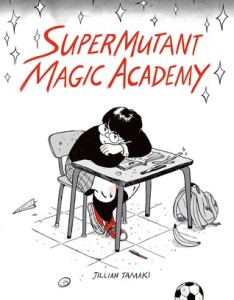 SuperMutant Magic Academy by Jillian Tamaki (Drawn & Quarterly, 2015)
SuperMutant Magic Academy by Jillian Tamaki (Drawn & Quarterly, 2015)
SuperMutant Magic Academy is what happens when teens with powers don’t fight other teens or adult authorities. These fights serve as overblown and violent metaphors for growing up, and they usually eclipse the personal, internal struggles that fill our school years.
Using mostly one- and two-page scenes, Tamaki zeroes in on that emotional turmoil: awkward anxiety, deadpan disgust, pipe dream romance, and more. But it’s real funny too.
Mighty Star and the Castle of the Cancatervater by A. Degen (Koyama Press, 2015)
A penny dreadful superhero fights cloudy allegories amidst somnambulist landscapes in a hectic and wordless comic. Degen’s art captures a sense of herky-jerky movement, as if the whole thing is an automated toy in a shadow box with someone turning a crank to make it wiggle.
O Human Star by Julie Delliquanti (self-published, 2015)
Famed roboticist Alastair Sterling wakes up to a world that isn’t what he remembered. He learns that he died but had his consciousness uploaded into a perfect robotic replica. In trying to figure out who brought him back and why, he moves in with his old lover/business partner, Brendan, and Brendan’s robot daughter, modeled on Alastair before she decided she was a girl.
Delliquanti gracefully balances sci-fi concepts with intersections of gender and sexuality. Come for the high concepts; stay for the well-developed characters and masterful pacing.
Eat More Comics by Matt Bors (editor) (The Nib, 2015)
Chances are you’ve already seen comics from The Nib. They’ve made the rounds on social media because they’re the best editorial comics being made. This collection is a very nice package, but it isn’t without its problems. There are a number of typos, such as misspelling some of the contributors’ names. Also, a tier of panels is printed twice. If these things bug you, wait for a corrected printing. In the end, though, it’s worth having these comics around despite the small flaws. Check out some of my favorites:
– “The Highgate County Fancy Chicken Show” by Eleanor Davis
– “Lighten Up” by Ronald Wimberly
– “Not All Men” by Matt Lubchansky
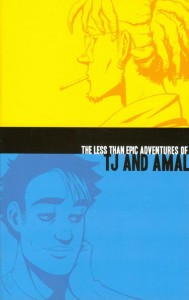 The Less Than Epic Adventures of TJ and Amal by EK Weaver (Iron Circus Comics, 2015)
The Less Than Epic Adventures of TJ and Amal by EK Weaver (Iron Circus Comics, 2015)
Weaver’s road trip/romance comic began serialization in 2009, and it finally gets the book treatment it deserves. Inside a handsome cover, TJ and Amal get high, get in fights, get busy, and eventually get where they were trying to go. Weaver excels at trapping her characters in well-defined spaces like car interiors and hotel rooms; she contrasts these tight quarters with sublime American vistas. This physical squeeze-and-release mirrors the ebbs and flows of the titular characters’ growing relationship.
Orion Omnibus by Walt Simonson & friends (DC Comics, 2015)
Originally serialized from 2000 to 2002, Orion finally gets the collection it deserves. Almost. Sort of. The series is a tightly plotted sci-fi superhero book that draws inspiration from Greek tragedy: success leads to hubris leads to a fall and, because it’s a modern superhero book, comes back to redemption. Simonson is an expert at seeding multiple plots and cleanly tying them all together, and Orion is him at the top of his abilities.
The original issues had a lead feature and a back-up feature that spoke to the main feature in some way: sometimes it revealed past events, sometimes it followed a character that split from the main narrative, and sometimes it was world-building. Unfortunately, the omnibus collection puts all the back-up stories in one chunk at the end of the book, leaving a number of plot points unexplained if one reads the book straight through. Boo.
New Work
Well Come by Erik Nebel (Yeti Press Comics, 2015)
Nebel’s three-panel comics are boldly colored meditations on biology, relationships, metamorphosis, and cause and effect. Some feel anxious, as though the changes are unexpected and unwanted. Others are calming, with strange beings accepting a strange world. Nebel’s book gives him a chance to showcase longer work, stringing strips together until it feels like wandering through a dreamlike retro sidescrolling game.
Lumberjanes by Noelle Stevenson, Grace Ellis, Brooke Allen, & more (Boom! Studios, 2015)
A girls’ camp overrun by myths and monsters! Deep secrets of camp bureaucracy! The power of friendship! Also romance, good jokes, and neat merit badges. Look at the fun they’re having:
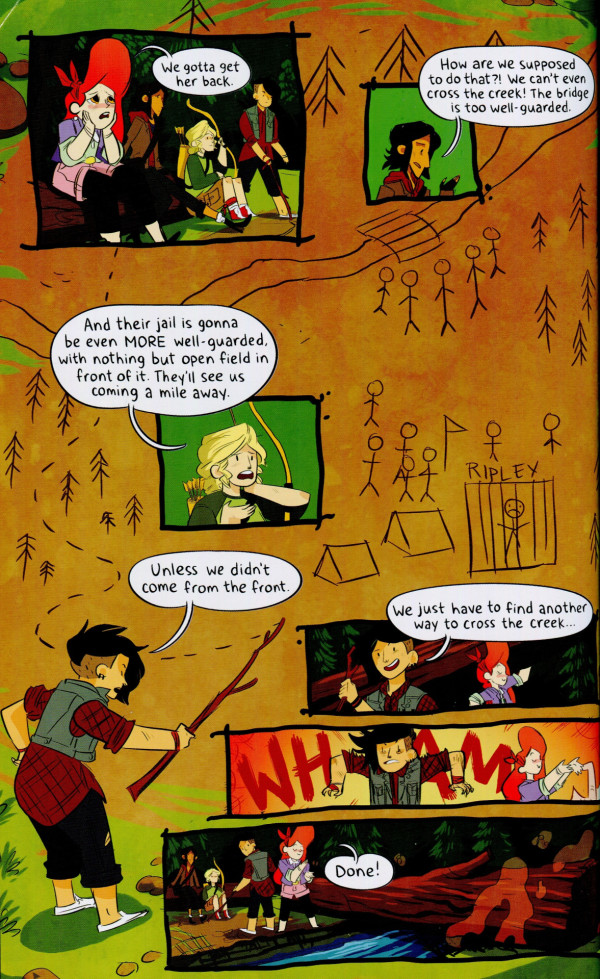
Captain America & the Mighty Avengers by Al Ewing, Luke Ross, Iban Coello, & more (Marvel Comics, 2015)
This was almost a real good comic! It had a multi-ethnic, multi-generational team of cool people with cool powers that sometimes argued but then teamed up to fight bad guys that represented bad things in the real world, like racism and corporations. It had snappy dialogue and clear storytelling. It had a grumpy wizard. It referenced Nextwave: Agents of HATE, the greatest superhero comic ever (or at least the vinegar reduction of superhero comics).
Unfortunately, Ewing and company had to tie their book into the events playing out in the rest of the Marvel universe, shoehorning in random plots that displaced the fun character work of Mighty Avengers. Then it got canceled because the Marvel Universe got destroyed (I think).
 Fütchi Perf by Kevin Czap (Czap Books, 2015)
Fütchi Perf by Kevin Czap (Czap Books, 2015)
Czap shows us a comic mixtape about a small-scale utopia where every party is as fun as you hoped it would be. It’s beautifully printed in sherbet tones of blue, pink, and purple. Czap’s lines undulate like friendly sound waves. It’s fearlessly optimistic, like a love letter from the future.
Grease Bats by Anna Bongiovanni (Autostraddle, 2015)
In a world where Archie Comics gets an avalanche of good press for acknowledging that gay men exist, Anna Bongiovanni is doing the real work of portraying queer besties and their daily struggles. The emotional range of the strips is great, from small, everyday worries (combating summer funk by perfecting your chair dance routine) to the wider concerns of queer culture (like the straight gentrification of queer events). There’s also the ever-present concern over romance, crushing, and Tinder-swiping.
Bongiovanni’s scratchy line is perfect for protagonists Scout and Andy’s adventures, from stoopin in the sunshine to drunkenly stumbling through a club, and I love the recent dips into spot coloring to highlight lovingly embroidered butts and last-minute jelly bean costumes.
 Big Pussy by Gina Wynbrandt (2dcloud, 2015)
Big Pussy by Gina Wynbrandt (2dcloud, 2015)
When it’s time to become an adult, you must participate in the time-honored tradition of trying to get some cats to give you superpowers but then just hanging out with them, drinking and fornicating, until you end up on a daytime talk show. Big Pussy is the weirdest, funniest comic I read all year. The scariest thing that happened all year was that I thought I lost my copy, so I bought a second one, but then I found my first one, so I left it out on my coffee table. My roommates and their boyfriends read it and couldn’t comfortably discuss it. Wynbrandt’s photo-referenced art approaches an uncanny valley, feeling like a kid kept posed for a photograph for too long; and I mean that in the best way, since it perfectly fits the awkward demands of bully mentor cats with human meme faces.
Well, everyone, that’s 12 comics for you to buy and parcel out to yourself over the next year. What were your favorites?

